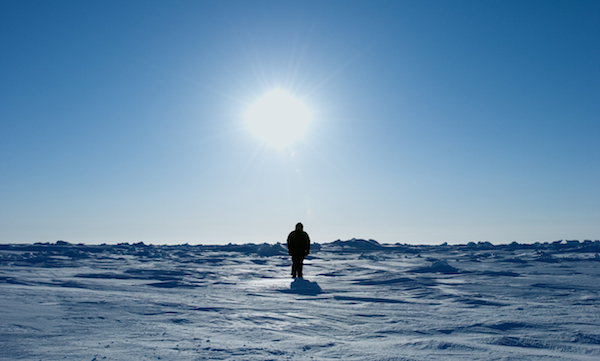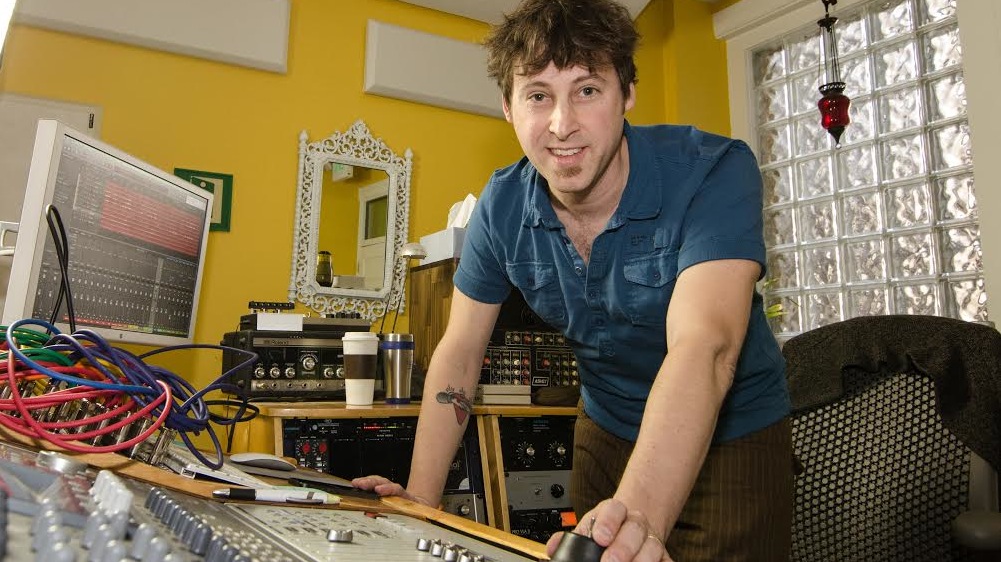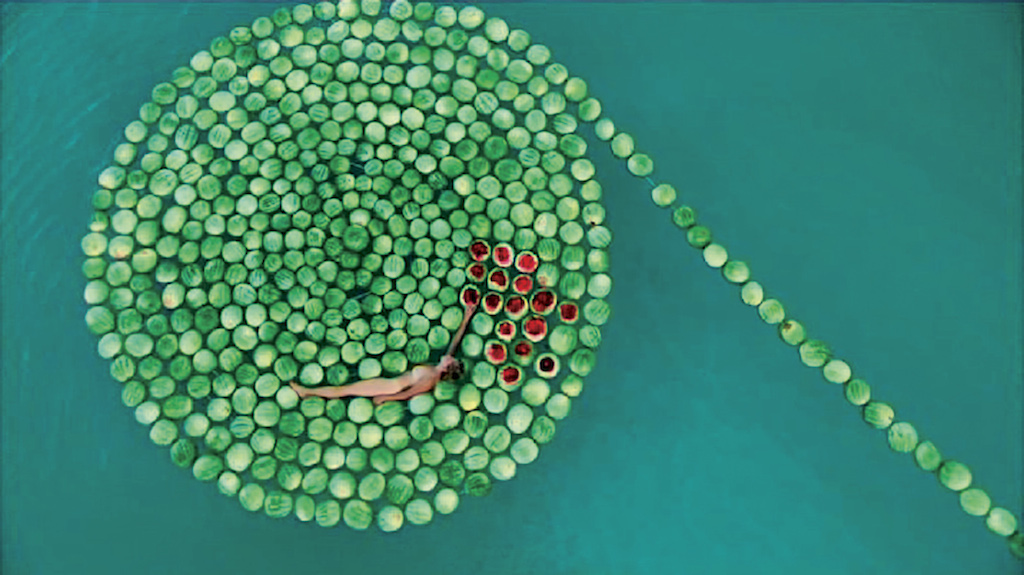Days of Endless Time at the Hirshhorn by Kerr Houston
So let’s begin by getting a few things out of the way. This essay is 2,063 words, or ten paragraphs long. It should thus take an average reader about eight minutes. But you’re not an average reader, are you? I mean, yeah, sure, you’re you, but you’re also an online reader – which means that you’re unlikely to engage very fully with any piece of writing more than a few hundred words long.
Indeed, about 38 percent of the readers who landed on this page have already moved on. And another 36 percent of you will give up by the second paragraph: perhaps it’s off to Facebook, or to toy with your fantasy football roster. And what of you few intrepid readers who actually do make it to the end of this essay? Well, don’t expect too much applause: after all, studies have shown that you’re likely scanning much of what you see, and actually processing only about 28 percent of the words on the screen.
In short, our reading habits are evolving: as many writers have noted, we’re increasingly accustomed to reading in small doses. As Andrew Dillon, dean of the School of Information at the University of Texas, puts it, “We’re spending so much time touching, pushing, linking, scrolling and jumping through text that, when [you] sit down with a novel, your daily [habit] of jumping, clicking, linking is just ingrained in you.” But of course such changes aren’t only evident in our reading.
It’s also increasingly clear that we now also look at art in rapid and disjointed ways. Timing and tracking surveys conducted at the Detroit Institute of Arts, for instance, revealed that the average visitor spent about four minutes in each gallery. Meanwhile, studies done elsewhere have indicated that viewers typically engage with a work of art, on average, for between 15 and 30 seconds. Even the Louvre has found, in fact, that its visitors gaze upon the Mona Lisa for about 15 seconds –and then move on, or pose for a selfie.
Unsurprisingly, curators and contemporary artists have begun to respond to such findings. In some cases, they’ve catered to shorter attention spans: the DIA, for instance, recently shortened its wall texts, from 250 words to 150. In other cases, they have created works that largely embrace and embody modern modes of perception: think of the videos of Ryan Trecartin (who, as Calvin Tomkins has pointed out, “came of age when new technologies were changing the way we look at moving images… and the Internet was messing with our brains”).
And then, too, they have sometimes begun to fight back, emphasizing the value of slow, extended looking. T.J. Clark and James Elkins, for instance, have written about the rewards of the sustained study of single artworks, and James Pawelski has recently begun taking his students to the Barnes Foundation, and requiring that they spend at least 20 minutes before a single painting. Similarly, a number of museums are now participating in Slow Art Day (the next is slated for April 11, 2015), when visitors are encouraged to look slowly at selected works.
But perhaps this interest in sustained or meditative engagement is most interestingly manifested in a band of contemporary art that has embraced slowness and subtlety. And, as an introduction to such work, a current show at the Hirshhorn – Days of Endless Time, co-organized by Kelly Gordon and Mika Yoshitake and scheduled to run through April April 6 is both useful and provocative. Featuring fourteen video installations that variously invoke the attenuation of time and suggest the potency of absorption, the show manifests a creative response to what the museum characterizes as the “frantic, 24/7 flow of information.” At the same time, however, a number of the works ultimately imply a recurrent fascination with artificiality, and screens and surfaces – and as are thus perhaps as much a product of our mediated, pixelated experience of reality as they are a reaction against it. We may claim to yearn, that is, respites from instantaneity. But, concurrently, it’s becoming clear that we conceive of those respites in terms of the very same devices that make instantaneity possible.

The first work in the show is well chosen, as it establishes a number of relevant leitmotifs. In Su-Mei Tse’s L’Echo, the artist (a trained cellist whose installation won the Golden Lion at the 2003 Venice Biennale) is dressed in bright red, and seems to be seated on a verdant Alpine slope. She plays brief passages on her instrument and pauses, allowing the sounds to echo off an opposing slope that fills much of the composition.
In a basic sense, then, the piece evokes the sheer majesty of nature and the boggling scale of geological time: in such a setting, the cellist seems fragile, out of place. As the returned sound mingles with her melodies, a relationship takes shape and we can sense the appeal of Ruskin’s pathetic fallacy: the landscape seems alive. But then we note, too, that the returned sound is out of synch and diminished; the echo is a faint, degraded variant of the original. And so the video suggests, touchingly, its own limitations. Like a melody that reverberates, a video is merely a trace of a live performance that is in some ways inevitably fuller and lusher than the reproduction.
Sigalit Landau’s DeadSee, an 11-minute video piece (still pictured at top), also rewards. Consisting of a single, extended shot, it opens with a tightly cropped image of what we come to realize are watermelons: 500 watermelons, it turns out, tied to each other in a sprawling spiral floating on the surface of the Dead Sea. As we watch, the fruit slowly spools past us – until we also see, interspersed, the drifting nude form of the artist and seventeen shattered melons, their green hulls pierced, revealing the bright red meat inside. The effect is at once stately and surreal, for the twisting spiral and restrained pace evoke cosmic forms and elapsed footage of blooming flowers, even as the smooth, white flank of the body and the bloody red of the fruit hint at a latent violence. Billie Holliday’s Strange Fruit comes to mind. But so, too, does Alfred Hitchcock’s Psycho, with its conflation of the lifeless eye of Marion Crane and the eddy of water in the nearby shower basin. The rich saline content of the Dead Sea, we see, can literally support life. But it is also, we sense, something unnatural: something eerie, and threatening.

Indeed, the notion of a strained, self-conscious relationship to nature recurs in these works. Several of them suggest an interest in the redemptive potential or noble grace of the natural environment. Eija-Liisa Ahtila’s Horizontal, for instance, shows the artist standing at the base of a massive spruce, which ripples in the breeze: the tree is majestic, and becomes a sort of protagonist. David Claerbout’s Travel, meanwhile, leads us on a gentle, gliding trip through a sequence of appealing, digitally constructed landscapes, against a ground of what the artist has called “therapeutic music.”
But even these artists are simultaneously alert to the artificiality of such representations of nature. Claerbout’s piece, for instance, wants to be read in the light of Diderot’s well-known gambit of describing a walk through the landscapes of Horace Vernet: an approach that at once celebrated Vernet’s ability to recreate nature and accented the limited reality and artifice of such work. In the same way, Ahtila’s piece openly acknowledges its own conceit. Projected on six screens, it alludes to the fact that it was shot with six cameras inserted into a forest canopy at various heights – giving us, ultimately, a view that is both breathtaking and disembodied.

Such a sense of self-consciousness often characterizes the artists’ use of screens, as well. Again and again, these works return our attention to the basic fact of projection. This is most obvious in Hans-Peter Feldmann’s delightful Shadowplay, in which a range of toys and objects (dolls; a hairbrush; a pistol) rotate on motorized carousels as backing lights cast their moving shadows upon the gallery wall. The result is moving, and combines a sweet sense of nostalgia with a range of allusions: as Philip Kennicott noted in the Post, we might think of Plato’s allegory of the cave, or of a moment in A Remembrance of Things Past, in which a boy lies awake and watches the colors cast on a wall by a magic lantern. The gallery wall is thus converted into a rich, evocative surface. But an interest in metaphor is also evident in other works, too.
In Rocking Chair, projected onto both faces of a screen, Claerbout offers an image of a woman rocking on a porch; thanks to two motion sensors, she slowly ceases her rocking when we move. The projection screen thus becomes something like a window screen, compromising and complicating our sense of privacy. Or take Douglas Gordon’s Play Dead, in which a trained elephant lies down, upon command – but then grows restless, and rises again. Filmed from various angles and shown on two large screens and a small monitor, this is a work that is centrally interested in appearance, and display. And so the screens, we might say, thus become an elephant in the room: a central, unavoidable fact.

In the process, the element of time also becomes important. In one piece in the show, in fact, it is is absolutely central: that’s Guido van der Werve’s Nummer Negen (#9): The Day I Didn’t Turn With the World, a 9-minute video in which the artist stands under bright skies at the North Pole and slowly turns in concert with his shadow for a full 24 hours, so that his own rotations coincide with those of the earth. The conceit, then, is grand – man, aligned with planet and time – but the result is arguably self-mocking: van der Werve’s edited movements appear jerky and almost ridiculous. Or perhaps we could say that such a piece, despite its cosmic logic, is actually reassuringly modest in terms of its temporal scale. Nine minutes? We race, as a species, to stand upon the poles; we boldly impose ourselves upon the axis of the world.
And yet we seem unable, for the most part, to concentrate for more than a few ticks of the clock. Most of the videos in the show, in fact, are rather short in duration: six minutes, or ten minutes, or twelve. These are nothing like, in other words, Andy Warhol’s 8-hour Empire, a slow-motion long take of the Empire State Building, or Christian Marclay’s remarkable The Clock, a 24-hour compilation of segments of film that suggests a fusion of filmic and lived time. Rather, much as the artists in Days of Endless Time are candidly alert to the fact of projection, they are attentive too to the limited attention spans of their likely audiences.
For, after all, as James Pawelski has argued, twenty minutes these days is what three hours used to be. And so most visitors to the Hirshhorn spend only a minute or two with L’Echo, and drift quickly through Play Dead. True, the soft chairs placed in a row before Shadowplay regularly attract small crowds of viewers, and the restrained pace of DeadSee can be sedating. But even if we sit transfixed before such work, we soon recall that Lot’s wife was punished harshly for looking too long, upon the shores of the Dead Sea.
So we move on – or check our phone, or click on a link and abandon the essay before reading it to the end. Rare indeed is the contemporary viewer, or reader, who can spend hours with a work. And rare now, too, implies this show, is the artwork that does not know and respond to this fact. Unending days may be an appealing ideal. But we always also know that days do end, and that even minutes are precious. The Hirshhorn’s latest show reminds us of those facts, while teaching us to both love and mock ourselves as we try to halt the path of the sun, or to listen to ourselves in the faces of mountains.
Days of Endless Time runs at the Hirschhorn through Monday, April 6, 2015.
Author Kerr Houston teaches art history and art criticism at MICA; he is also the author of An Introduction to Art Criticism (Pearson, 2013) and recent essays on Wafaa Bilal, Emily Jacir, and Candice Breitz.






